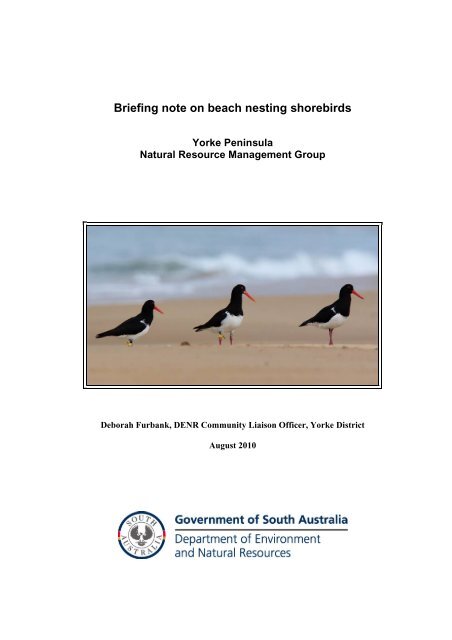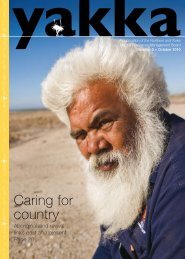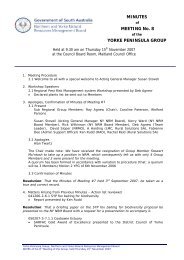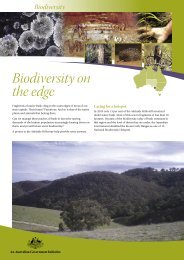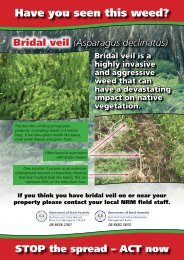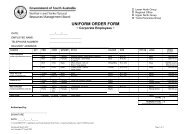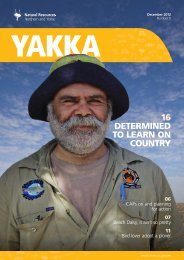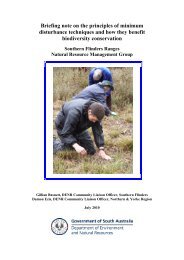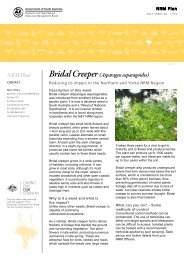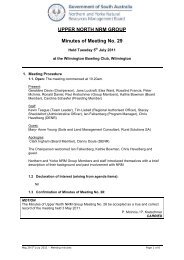Briefing note on beach nesting shorebirds - Northern and Yorke ...
Briefing note on beach nesting shorebirds - Northern and Yorke ...
Briefing note on beach nesting shorebirds - Northern and Yorke ...
Create successful ePaper yourself
Turn your PDF publications into a flip-book with our unique Google optimized e-Paper software.
<str<strong>on</strong>g>Briefing</str<strong>on</strong>g> <str<strong>on</strong>g>note</str<strong>on</strong>g> <strong>on</strong> <strong>beach</strong> <strong>nesting</strong> <strong>shorebirds</strong><br />
<strong>Yorke</strong> Peninsula<br />
Natural Resource Management Group<br />
Deborah Furbank, DENR Community Liais<strong>on</strong> Officer, <strong>Yorke</strong> District<br />
August 2010
Introducti<strong>on</strong><br />
The <strong>beach</strong>es <strong>on</strong> the <strong>Yorke</strong> Peninsula provide important <strong>nesting</strong> habitat for several species of<br />
resident <strong>beach</strong> <strong>nesting</strong> <strong>shorebirds</strong>. The Hooded Plover, the Sooty Oystercatcher, the Pied<br />
Oystercatcher <strong>and</strong> the Red-capped Plover lay their eggs in the s<strong>and</strong>, above the high tide mark.<br />
Beach <strong>nesting</strong> <strong>shorebirds</strong> are in danger of becoming extinct as co-existing with humans threatens<br />
their ability to breed successfully.<br />
Beach <strong>nesting</strong> birds are very sensitive to changes in their envir<strong>on</strong>ment. With over 80% of<br />
Australians living within 50km of the coast, humans have upset the natural balance through the<br />
destructi<strong>on</strong> <strong>and</strong> modificati<strong>on</strong> of habitat. C<strong>on</strong>structi<strong>on</strong> of marinas, coastal stabilisati<strong>on</strong> projects <strong>and</strong><br />
vehicle access to the <strong>beach</strong> can all have a detrimental effect <strong>on</strong> successful breeding. Beach<br />
<strong>nesting</strong> birds prefer a s<strong>and</strong> dune which is sparsely vegetated with native grasses as a <strong>nesting</strong> site.<br />
Erosi<strong>on</strong> <strong>and</strong> erosi<strong>on</strong> c<strong>on</strong>trol methods such as Marram grass effect habitats suitable for <strong>nesting</strong>.<br />
Beach <strong>nesting</strong> birds lay their eggs <strong>on</strong> the <strong>beach</strong> or in the dunes, close to their food source, from late<br />
spring <strong>and</strong> into summer, at the time when <strong>beach</strong> visitati<strong>on</strong> is at its highest. The eggs are speckled<br />
<strong>and</strong> blend in with the shallow nest of grainy s<strong>and</strong>. This camouflage gives the eggs protecti<strong>on</strong><br />
against native predators. It also means they are hard to see for humans who can accidentally step<br />
<strong>on</strong>, or drive over them.<br />
Many species of <strong>beach</strong> <strong>nesting</strong> birds have experienced populati<strong>on</strong> declines. M<strong>on</strong>itoring programs<br />
are being undertaken across Australia to determine the status of <strong>beach</strong> <strong>nesting</strong> birds <strong>and</strong> the<br />
effectiveness of management regimes. On the <strong>Yorke</strong> Peninsula volunteers take part in the<br />
Shorebirds 2020 program which includes the m<strong>on</strong>itoring of <strong>beach</strong> <strong>nesting</strong> birds. Hooded Plover<br />
surveys occur over the <strong>Yorke</strong> Peninsula, as part of nati<strong>on</strong> wide surveys coordinated by Birds<br />
Australia, every sec<strong>on</strong>d year.<br />
Hooded Plover<br />
Descripti<strong>on</strong>: The Hooded Plover is a<br />
medium sized bird measuring 19-23 cm in<br />
length <strong>and</strong> approximately 10cm in height.<br />
Both sexes have a black hood, a white collar<br />
across the back of the neck, with a black<br />
b<strong>and</strong> underneath the collar <strong>and</strong> around the<br />
bird’s shoulders. It has brownish-grey<br />
upperparts <strong>and</strong> white underparts. Its bill is<br />
red with a black tip, it has red rings around<br />
its eyes <strong>and</strong> orange–pink legs.<br />
<strong>Yorke</strong> Peninsula <strong>beach</strong> <strong>nesting</strong> <strong>shorebirds</strong><br />
Hooded Plovers (Glenn Ehmke)
Habitat: Hooded Plovers prefer wide, flat s<strong>and</strong>y <strong>beach</strong>es with oceans that cast seaweed <strong>on</strong>to the shore.<br />
They like sparsely vegetated s<strong>and</strong> dunes for shelter <strong>and</strong> <strong>nesting</strong>. They can also be found <strong>on</strong> estuaries,<br />
tidal bays, rock platforms <strong>and</strong> rocky reefs near s<strong>and</strong>y <strong>beach</strong>es.<br />
Diet: Crustaceans, insects, polychaetes (marine worms), molluscs, turi<strong>on</strong>s (aquatic buds) <strong>and</strong> seeds.<br />
Hooded Plovers feed in a run stop peck manner.<br />
Breeding: Breeding seas<strong>on</strong> occurs in South Australia from August to April. Hooded plovers breed in<br />
single pairs. 2-3 eggs are laid in a shallow nest in the s<strong>and</strong> above the high tide mark. Both parents<br />
incubate for approximately four weeks. The chicks fledge after 33-36 days.<br />
Status: The Hooded Plover is listed as vulnerable in South Australia <strong>and</strong> <strong>on</strong> the <strong>Yorke</strong> Peninsula<br />
(Nati<strong>on</strong>al Parks <strong>and</strong> Wildlife Act). In South Australia the populati<strong>on</strong> is estimated at 320-540 birds.<br />
Pied Oystercatcher<br />
Descripti<strong>on</strong>: The Pied Oystercatcher is a large bird measuring 42-50cm l<strong>on</strong>g with a wing span of up to<br />
95cm. It has black upperparts <strong>and</strong> white underparts with a l<strong>on</strong>g orange-red bill <strong>and</strong> pink legs <strong>and</strong> feet.<br />
The sexes are similar but the female is slightly larger than the male with a slightly l<strong>on</strong>ger <strong>and</strong> more<br />
slender bill.<br />
Habitat: Pied Oystercatchers can be found <strong>on</strong> s<strong>and</strong>y st<strong>on</strong>y or rocky estuaries, inlets <strong>and</strong> <strong>beach</strong>es,<br />
preferring intertidal mudflats <strong>and</strong> s<strong>and</strong>banks in large marine bays. They also occur <strong>on</strong> spits, s<strong>and</strong> bars<br />
<strong>and</strong> <strong>on</strong> coastal isl<strong>and</strong>s.<br />
Diet: Molluscs, worms <strong>and</strong> crabs.<br />
Breeding: Breeding occurs from September to January in southern Australia. Pied Oystercatchers nest<br />
in a scrape in s<strong>and</strong>, shingle or shell grit. The nest can be found <strong>on</strong> the <strong>beach</strong>, <strong>on</strong> s<strong>and</strong> dunes, <strong>on</strong> s<strong>and</strong>bars,<br />
in an estuary or am<strong>on</strong>gst vegetati<strong>on</strong>. The nest is often lined with shells, seaweed, seagrass or other<br />
vegetati<strong>on</strong>. Pairs have a <strong>nesting</strong> territory which<br />
they will return to every year. Both parents<br />
incubate <strong>and</strong> feed the young. Incubati<strong>on</strong> takes<br />
26- 29 days with a clutch size of 1-3 eggs. The<br />
chicks fledge at 7-8 weeks of age.<br />
Status: The Pied Oystercatcher is listed as rare<br />
in South Australia (Nati<strong>on</strong>al Parks <strong>and</strong> Wildlife<br />
Act). On the <strong>Yorke</strong> Peninsula it is listed as near<br />
threatened (Gillam <strong>and</strong> Urban, 2008).<br />
Pied Oystercatcher (Glenn Ehmke)
Sooty Oystercatcher<br />
Descripti<strong>on</strong>: The Sooty Oystercatcher is a large black bird measuring 40-52 cm in length, with a wing<br />
span of up to 100cm. It has a l<strong>on</strong>g red bill, a red ring around its eyes <strong>and</strong> pink legs. Both sexes are<br />
similar although the female has a l<strong>on</strong>ger more slender bill.<br />
Habitat: The Sooty Oystercatcher is a coastal bird <strong>and</strong> is usually found within 50m of the ocean. It<br />
prefers rocky shores but it can sometimes be seen <strong>on</strong> coral reefs or s<strong>and</strong>y <strong>beach</strong>es near estuarine<br />
mudflats.<br />
Diet: Molluscs, crustaceans, polychaetes (marine worms), ascidians (sea squirts), echinoderms (sea<br />
urchins, sea stars etc.) <strong>and</strong> small fish.<br />
Breeding: Breeding seas<strong>on</strong> is from October to January in southern Australia. The Sooty Oystercatcher<br />
breeds <strong>on</strong> offshore isl<strong>and</strong>s <strong>and</strong> isolated rocky headl<strong>and</strong>s. The young are independent 100-200 days after<br />
hatching. They nest above the high tide mark, in<br />
a scrape <strong>on</strong> s<strong>and</strong>, gravel, shingle or rocks. The<br />
nest may be lined with pebbles, shells,<br />
seaweed, seagrass, samphire or other<br />
vegetati<strong>on</strong>. The clutch c<strong>on</strong>sists of 1-3 eggs. Both<br />
parents incubate <strong>and</strong> feed the chicks.<br />
Status: The Sooty Oystercatcher is listed as<br />
rare in South Australia (Nati<strong>on</strong>al Parks <strong>and</strong><br />
Wildlife Act). On the <strong>Yorke</strong> Peninsula it is also<br />
listed as rare (Gillam <strong>and</strong> Urban 2008).<br />
Sooty Oystercatcher (Glenn Ehmke)<br />
Red-capped Plover<br />
Descripti<strong>on</strong>: The Red-capped Plover is a small<br />
grey-brown <strong>and</strong> white bird measuring 14-16cm<br />
in length. The adult male has a chestnut-red<br />
crown <strong>and</strong> nape with a grey mantle. It has a<br />
black b<strong>and</strong> running from the nape to the sides of<br />
the breast <strong>and</strong> black lines from the bill past the<br />
eye. The female has duller plumage <strong>and</strong> is<br />
missing the black markings of the male. Both<br />
sexes have a fine bill <strong>and</strong> white underparts.<br />
Young birds are similar but paler than the adults.<br />
Red Capped Plover (Laura Glenister)
Habitat: The majority of Red-capped Plovers occur inl<strong>and</strong> around salt lakes with sparse vegetati<strong>on</strong>.<br />
They can also occur in bays, inlets, estuaries, river deltas <strong>and</strong> lago<strong>on</strong>s, saltpans saltmarsh <strong>and</strong> <strong>beach</strong>es<br />
backed by dunes or banks of s<strong>and</strong>.<br />
Diet: Annelids (worms), molluscs, small crustaceans <strong>and</strong> some vegetati<strong>on</strong>.<br />
Breeding: Breeding seas<strong>on</strong> for the Red-capped Plover occurs between July <strong>and</strong> January in southern<br />
Australia <strong>and</strong> sometimes until as late as March. They nest <strong>on</strong> the ground in s<strong>and</strong>, shell grit, mud or st<strong>on</strong>y<br />
areas. This occurs <strong>on</strong> <strong>beach</strong>es, dunes, s<strong>and</strong> spits <strong>and</strong> salt lakes. The nest may be lined with shells,<br />
st<strong>on</strong>es, grass, salt bush, seaweed, twigs, feathers or sheep dung. The clutch c<strong>on</strong>sists of 1-3 eggs which<br />
have an incubati<strong>on</strong> period of 30-31 days. The female does most of the incubati<strong>on</strong> but both parents<br />
defend the nest <strong>and</strong> young.<br />
Status: The Red-capped Plover is listed as rare <strong>on</strong> the southern <strong>Yorke</strong> Peninsula but is listed of least<br />
c<strong>on</strong>cern in the St Vincent regi<strong>on</strong>, further up the peninsula (Gillam <strong>and</strong> Urban 2008).<br />
Other Beach-nesters<br />
There are other bird species that may nest <strong>on</strong> the <strong>beach</strong>es of the <strong>Yorke</strong> Peninsula. The Masked Lapwing<br />
may occasi<strong>on</strong>ally nest <strong>on</strong> the <strong>beach</strong> but is more likely to nest inl<strong>and</strong>. Terns are a group of birds that nest<br />
<strong>on</strong> <strong>beach</strong>es, but mostly occur in col<strong>on</strong>ies, even when breeding. This makes them less vulnerable to<br />
human impact than the resident <strong>shorebirds</strong> previously menti<strong>on</strong>ed <strong>and</strong> requires different management<br />
techniques. All of the tern species that nest <strong>on</strong> Australian <strong>beach</strong>es are listed as of Least C<strong>on</strong>cern<br />
according to the IUCN Red List (2008).<br />
Human impact <strong>on</strong> <strong>beach</strong> <strong>nesting</strong> <strong>shorebirds</strong><br />
Many threats impact the success rate of breeding for <strong>beach</strong> <strong>nesting</strong> <strong>shorebirds</strong> either directly or indirectly.<br />
In the 2008 Hooded Plover biennial count, Point Turt<strong>on</strong>, Daly Heads, Port Germein <strong>and</strong> Cape Elizabeth<br />
recorded high threat scores.<br />
Vehicles<br />
Off road vehicles make survival hard for <strong>beach</strong> <strong>nesting</strong> birds which require undisturbed <strong>beach</strong>es for<br />
successful breeding. Vehicles have the ability to access remote areas that were previously inaccessible<br />
<strong>and</strong> undisturbed. 4WDs, trail bikes <strong>and</strong> quad bikes have the potential to impact heavily <strong>on</strong> the populati<strong>on</strong><br />
of <strong>beach</strong> <strong>nesting</strong> shore birds. Incubating adults can be disturbed from the nest, this has the potential to<br />
cause nest failure especially if the temperature is above 30°C. Foraging chicks can be disturbed from<br />
feeding. If the tiny chicks are using their energy to run <strong>and</strong> hide from vehicles <strong>and</strong> are unable to feed this<br />
can lead to starvati<strong>on</strong>. Eggs can be destroyed by vehicles travelling in s<strong>and</strong> dunes or above the high tide<br />
mark.<br />
Management opti<strong>on</strong>s:<br />
• Bollards <strong>and</strong> fencing to prevent vehicle access to <strong>beach</strong>es.<br />
• Signage indicating <strong>nesting</strong> sites.<br />
• Chick shelters offering a hiding place from approaching vehicles (but little protecti<strong>on</strong>).<br />
• Site closures during breeding seas<strong>on</strong>.<br />
• Regulati<strong>on</strong>s or policy changes relating to <strong>beach</strong> driving.<br />
• Educati<strong>on</strong>al programs.
Introduced predators<br />
Foxes, cats <strong>and</strong> rats are predators of <strong>beach</strong> <strong>nesting</strong> shore birds <strong>and</strong> their eggs.<br />
Management opti<strong>on</strong>s:<br />
• Baiting, but this has a risk of off target impact <strong>on</strong> n<strong>on</strong> target animals such as domestic dogs.<br />
• Trapping, spotlight shooting <strong>and</strong> den destructi<strong>on</strong>.<br />
• Policy enforcing cats to be kept indoors at night.<br />
Recreati<strong>on</strong>al activities<br />
Humans using the <strong>beach</strong> or s<strong>and</strong> dunes for recreati<strong>on</strong>al activities during breeding seas<strong>on</strong> are likely to<br />
disturb incubating birds or foraging chicks. This can cause breeding failure or starvati<strong>on</strong> of the chicks.<br />
The majority of humans travel al<strong>on</strong>g the hard wet s<strong>and</strong> where they are less likely to impact <strong>nesting</strong> birds.<br />
Those who travel above the high tide mark or through the dunes risk crushing eggs or chicks.<br />
When the tide is high horse riding often occurs above the high tide mark. Horses can crush eggs <strong>and</strong><br />
chicks <strong>and</strong> also injure or kill adult birds. Horse riding can also disturb incubating birds <strong>and</strong> feeding chicks.<br />
Riding through the dunes can cause heavy erosi<strong>on</strong>.<br />
When accompanied by a dog, people have a greater impact <strong>on</strong> <strong>beach</strong> <strong>nesting</strong> <strong>shorebirds</strong>, especially if<br />
the dog is unleashed. Birds are more easily frightened off the nest by dogs. Dogs can destroy <strong>nesting</strong><br />
sites, crush eggs <strong>and</strong> chase <strong>and</strong> kill chicks <strong>and</strong> adult birds.<br />
Management opti<strong>on</strong>s:<br />
• Signage directing <strong>beach</strong> goers <strong>and</strong> their animals away from <strong>nesting</strong> sites.<br />
• Fences, permanent or temporary designed to reduce erosi<strong>on</strong> <strong>and</strong> the risk of eggs or chicks getting<br />
crushed.<br />
• Site closures during breeding seas<strong>on</strong>.<br />
• Site wardens can be used in busy periods to reinforce messages <strong>on</strong> signage.<br />
• Educati<strong>on</strong>al programs <strong>and</strong> materials raising public awareness.<br />
• Keep dogs leashed in breeding areas.<br />
• Provide chick shelters so chicks can hide from approaching dogs.<br />
Introduced plants<br />
Weeds such as Sea Spurge can alter dunes <strong>and</strong> <strong>beach</strong>es, limiting available <strong>nesting</strong> sites for <strong>beach</strong><br />
<strong>nesting</strong> <strong>shorebirds</strong>. The use of dune stabilising grasses, such as marram grass, changes the shape of<br />
s<strong>and</strong> dunes <strong>and</strong> limits the amount of unvegetated area above the high tide line. This limits where nests<br />
can be built <strong>and</strong> has the potential to harbour predators.<br />
Management opti<strong>on</strong>s:<br />
• Weed c<strong>on</strong>trol.<br />
• Use alternative methods of dune stabilisati<strong>on</strong> such as brush laying, but <strong>on</strong>ly <strong>on</strong> the upper dune. Make<br />
sure bare s<strong>and</strong> is available <strong>on</strong> lower dune for <strong>nesting</strong>. Use native grasses instead of introduced <strong>on</strong>es.<br />
• Create bare patches of s<strong>and</strong> am<strong>on</strong>gst dune vegetati<strong>on</strong>.
M<strong>on</strong>itoring <strong>beach</strong> <strong>nesting</strong> <strong>shorebirds</strong><br />
M<strong>on</strong>itoring provides informati<strong>on</strong> <strong>on</strong> <strong>beach</strong> <strong>nesting</strong> bird<br />
numbers, whether they are increasing or decreasing,<br />
why they are threatened <strong>and</strong> how we can implement<br />
management regimes to help them. It gives coastal<br />
communities an opportunity to engage in <strong>beach</strong><br />
<strong>nesting</strong> shorebird c<strong>on</strong>servati<strong>on</strong> which in turn indicates<br />
to the community the health of their coastal<br />
envir<strong>on</strong>ment.<br />
Since 1996 biennial Hooded Plover surveys have<br />
been occurring <strong>on</strong> the <strong>Yorke</strong> Peninsula. In 1996 <strong>and</strong><br />
1998, 400km of coastline was surveyed with 141 then<br />
182 plovers recorded. In recent years far less<br />
coastline has been surveyed due to the unavailability<br />
of volunteers <strong>on</strong> the <strong>Yorke</strong> Peninsula. With limited<br />
resources the focus has been <strong>on</strong> high energy s<strong>and</strong>y<br />
<strong>beach</strong>es which are the favoured habitat of the<br />
Hooded Plover. Pied Oystercatcher <strong>and</strong> Sooty<br />
Oystercatcher sightings are also recorded during the<br />
Hooded Plover count.<br />
The next biennial Hooded Plover count in South<br />
Australia will occur <strong>on</strong> the 13 th <strong>and</strong> 14 th of November<br />
2010. Glen Ewers from Birds Australia will be<br />
coordinating the count <strong>on</strong> the <strong>Yorke</strong> Peninsula.<br />
Community members interested in volunteering can<br />
c<strong>on</strong>tact him <strong>on</strong>: g.ewers@birdsaustralia.com.au<br />
Shorebird 2020 is a nati<strong>on</strong>wide program that m<strong>on</strong>itors<br />
all shore birds, including migratory birds. The key aim<br />
of the program is to collect data <strong>on</strong> the numbers of<br />
<strong>shorebirds</strong> in order to better manage <strong>and</strong> c<strong>on</strong>serve<br />
these birds. Whilst the main focus is <strong>on</strong> migratory<br />
birds, <strong>beach</strong> <strong>nesting</strong> birds are also surveyed as part<br />
of this program.<br />
Source: Birds Australia<br />
Shorebirds 2020 is a collaborative project between Birds Australia, The Australasian Wader Studies<br />
Group, the World Wildlife Fund <strong>and</strong> the Natural Heritage Trust. If members of the community are<br />
interested in taking part in the survey which occurs in between January <strong>and</strong> February they can find the<br />
c<strong>on</strong>tact pers<strong>on</strong> for their area <strong>on</strong> the Shorebirds 2020 website at : http://<strong>shorebirds</strong>.org.au/pdfs/Nati<strong>on</strong>alsite-c<strong>on</strong>tacts-list.pdf
Bibliography<br />
Baker-Gabb, D. <strong>and</strong> West<strong>on</strong>, M. (2006). South Australian Recovery Plan for the Hooded Plover Thinornis<br />
rubicollis.<br />
Campbell, C, Cullen, M, Thomas, J. <strong>and</strong> Maguire, G. (Nov 2008) Biennial Hooded Plover Count Report,<br />
Birds Australia.<br />
Department for Envir<strong>on</strong>ment <strong>and</strong> Heritage (Jan 2007). Hoods <strong>on</strong> the Beach, Hooded Plover Newsletter,<br />
South Australia.<br />
Gillam, S. <strong>and</strong> Urban, R. (2008) Species Risk Assessment Pilot Project Phase 1 Report: Regi<strong>on</strong>al Species<br />
C<strong>on</strong>servati<strong>on</strong> Assessments - Species status ratings <strong>and</strong> trends for the <strong>Northern</strong> <strong>and</strong> <strong>Yorke</strong> Natural<br />
Resource Management Group Regi<strong>on</strong>s, Department for Envir<strong>on</strong>ment <strong>and</strong> Heritage, South Australia.<br />
Maguire, G.S. (2008). A practical guide for managing <strong>beach</strong>-<strong>nesting</strong> birds in Australia. Birds Australia,<br />
Melbourne.<br />
Birds Australia: Beach Nesting Birds. Website accessed Aug 2010:<br />
http://www.birdsaustralia.com.au/our-projects/<strong>beach</strong>-<strong>nesting</strong>-birds.html<br />
Birds Australia: Hooded Plover. Website accessed Aug 2010:<br />
http://www.birdsaustralia.com.au/our-projects/hooded-plover.html<br />
Shorebirds 2020 (2009): Shorebird C<strong>on</strong>servati<strong>on</strong>. Website accessed Aug 2010:<br />
http://www.<strong>shorebirds</strong>.org.au/


